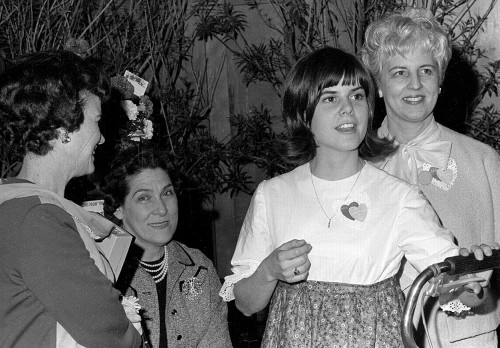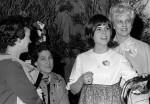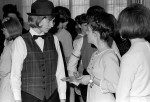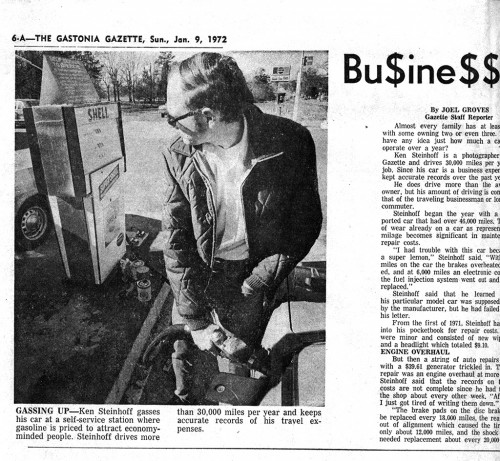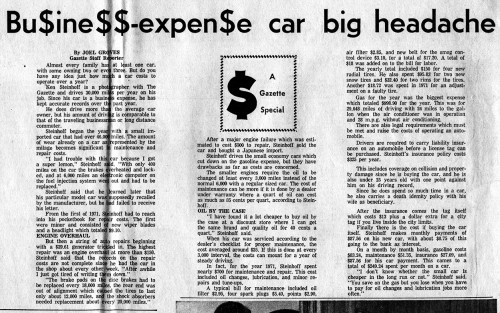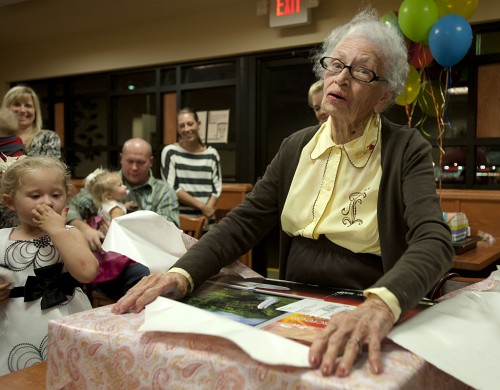 I was at the dinner table in Cape when Mother fired up the TV she got for her 90th birthday back in 2011 to catch The Wheel. The screen was black. So was the mood at the table. You do NOT trifle with The Wheel.
I was at the dinner table in Cape when Mother fired up the TV she got for her 90th birthday back in 2011 to catch The Wheel. The screen was black. So was the mood at the table. You do NOT trifle with The Wheel.
After an inordinate amount of time trying to get through to Charter customer service, I was told that the cable company had switched from analog service to digital service and that she would need converter boxes if she ever wanted to ever see The Wheel again. In the next 48 hours, I got three different versions of how many “free” boxes she could get, how long they would be “free” and how much it would cost per month when they were no longer “free.”
Earlier in the visit, I bought her a refurbished Roku HD Streaming player so she could watch Amazon Prime videos. (Brother Mark and I both have Prime accounts, but he never uses his for movies, so there wouldn’t be any conflict with her logging in under his name.) She liked the way she could start a movie on her iPad on the porch or in the living room, then pick it up on the TV in her bedroom.
Does she NEED cable?
The more I thought about the digital box rental issue, the more I wondered if she really NEEDED cable? Mark and I put our heads together and thought we could get her all the local stations with an off-the-air antenna (OTA), and she could watch other things on the Roku box. Ernie Chiles had an antenna that could be modified to do the job, but I was running short on time and decided to put the project on hold until my summer visit (when it should be really FUN working in the attic.)
Do the Florida Steinhoffs need cable?
 That got me to thinking: if Mother could survive without cable, maybe Wife Lila and I could. Son Matt said he dropped his cable several years ago and hadn’t missed it. To prepare for saying goodbye to Comcast, I had to order some stuff.
That got me to thinking: if Mother could survive without cable, maybe Wife Lila and I could. Son Matt said he dropped his cable several years ago and hadn’t missed it. To prepare for saying goodbye to Comcast, I had to order some stuff.
RCA ANT751 – an antenna capable of picking up a station 37.6 miles away. I decided to do a quick installation in the attic to see if it would work. I preferred not to mount it outside where it would be exposed to salt air and hurricanes. It exceeded expectations. In fact, I got the best result when I pointed the antenna to the south, even though the station furthest from us was to the north. Neighbor Jacqie was impressed enough that he ordered one for the narrow crawlspace of his apartment. He, too, was pleased. $47.99.
RCA Matching Transformer – VH54R – Some of the antenna reviews complained that the 300 ohm to 75 ohm transformer that came with the antenna wasn’t all that great. Jacqie’s worked fine and mine would probably work well, too, being in an attic. But, since I thought I might have to put the antenna on the roof, I opted to get a better transformer to be safe. $5.34.
Roku 2 Streaming Player – 2720R – We already had one Roku, but this would give us one on the living room set where I normally watch, and one for the sewing room set where Wife Lila usually sits. This has promoted domestic tranquility like nothing else I’ve bought recently. The speakers for the living room TV are on the wall between the living room and the bedroom. Since I usually watch a little TV before turning in after finishing the blog around 2 a.m., I have to ride the volume control knob to keep the sound high enough that I can hear it, but low enough that it doesn’t blow her out of bed. This Roku’s remote has a headphone jack on it. It’s amazing how much more you can hear through headphones than through the wall speakers. $59.99
Mediasonic HW-150PVR HomeWorx ATSC Digital TV Converter Box with Media Player and Recording PVR Function – only one of our TVs was new enough not to need a converter box. The good news is that this box is only $37.25 and it has the ability to record to an external hard drive. Since we’ve had TiVos for years, that was a nice feature. The bad news is that the remote was less than friendly and the interface for setting up recordings was even less intuitive. It WORKED, but I knew somebody in the house who wouldn’t like giving up the convenience of the TiVo.
What else did we need?
 Sons Matt and Adam bought me a monster TV for my birthday in 2004. It has served us well, but you can tell from the photos that it’s about the size and weight of a VW Bug. That’s Adam and his buddy, Jay, wrestling it into place when it was new. Taking out the cable box, hooking up the Roku and removing the TiVo wasn’t too much trouble. I managed to get the digital converter to record The Big Bang Theory, even if I hated the remote. I started binge-watching Dexter on Netflix and all was fine. I left Wife Lila on the cable until I figured out if this was going to work.
Sons Matt and Adam bought me a monster TV for my birthday in 2004. It has served us well, but you can tell from the photos that it’s about the size and weight of a VW Bug. That’s Adam and his buddy, Jay, wrestling it into place when it was new. Taking out the cable box, hooking up the Roku and removing the TiVo wasn’t too much trouble. I managed to get the digital converter to record The Big Bang Theory, even if I hated the remote. I started binge-watching Dexter on Netflix and all was fine. I left Wife Lila on the cable until I figured out if this was going to work.
We wanted a way to get some of the stuff that didn’t appear over the air.
Amazon Prime – we are already Prime subscribers, primarily for two-day shipping, free movies, free music and the like. We’re still on the $79 a year plan plan. New subscribers will pay $99.
Netflix – this is a video streaming service you can access through the Roku box. It’s good for movies and binge-watching multiple episodes of TV shows. Adam advocates this. Requires an Internet connection and costs $8 to $12 a month depending on how many simultaneous connections you want. The first month is free to try it out.
Hulu-Plus – Matt likes it. Unlike Netflix, their business model is built on showing you two or three episodes of current TV shows a day after they usually air. I hated it. The big deal-killer was that it has commercials embedded in it that can’t be skipped. If you have been using TiVo for years and got in the habit of never seeing a car salesman or a political attack ad, you have a low tolerance for ads. It also didn’t have some of the few regular network programs we had hoped to watch. I killed it at the end of the free week. About $8 a month.
How did it work out?
 Two days before the end of our Comcast cable billing cycle, I called to cancel our service. A very nice woman tried to tell me all the wonderful things we were going to miss, and I countered every argument. “Look,” I said, “it boils down to simple economics: we pay you about $84 a month for service; we pay TiVo about $21 bucks a month. We can pocket almost all of that money after a one-time outlay for equipment and a miniscule monthly charge for streaming services.”
Two days before the end of our Comcast cable billing cycle, I called to cancel our service. A very nice woman tried to tell me all the wonderful things we were going to miss, and I countered every argument. “Look,” I said, “it boils down to simple economics: we pay you about $84 a month for service; we pay TiVo about $21 bucks a month. We can pocket almost all of that money after a one-time outlay for equipment and a miniscule monthly charge for streaming services.”
“How about if I can get you down to $19.95 a month, plus $3.99 each for your two converter boxes. Would that make you stick around for 12 months?”
Wife Lila was giving me the thumbs-up in the background. It was worth that to keep her TiVo.
Re-inventing the wheel
 We opted to keep her office computer on the antenna in case the cable goes out, but I needed to reinstall all my equipment. To make a long, painful story short, I ran into snags. One of them was trying to get in behind the monster TV to plug stuff in and trace wires.
We opted to keep her office computer on the antenna in case the cable goes out, but I needed to reinstall all my equipment. To make a long, painful story short, I ran into snags. One of them was trying to get in behind the monster TV to plug stuff in and trace wires.
I told Wife Lila, “When I get the $50 million check from that Nigerian prince, the first thing I’m going to do is get a modern TV that weighs 13 pounds, not 13 tons.”
“The check should be here any day, and a new TV is less than $300, so go for it,” she said. (She was probably counting on my life insurance to kick in if the prince didn’t.)
I sent Matt an email telling him that he could have a really good TV set if (A) he carried it off and (B) helped me hook up all the pieces/parts.
He and Sarah of mileage log fame came by Saturday. We were holding Grandson Malcolm, who spent the night with us, as a hostage. Matt convinced me that we should disconnect everything, get it all plugged in, then see if it worked. In a mere four or five hours (without a single trip to Radio Shack or Best Buy), he had it hooked up, configured properly and doing all it was supposed to do. That cost both of us new TVs.
So what about Mother?
I learned that you can get good quality pictures with an antenna. Her stations are a little further away than our stations, but I’m still going to try mounting the antenna in her attic first. If that doesn’t do the job, then I’ll go on the roof or get a stronger antenna. She never has recorded shows, so that won’t be a factor. Since I don’t need the digital converters I bought for our sets, I’ll pass them on to her.
Disclosure: All of the links I provided are for Amazon. That’s where I bought my stuff. If you click on the link to make your purchase, I get about 6% of whatever you spend without it costing you a penny. All my research, trials and tribulations should be worth that much to you.
Last minute thought: there are some excellent resources out there to help you pick the right antenna based on where you live. I found a guy in the TV department at Cape’s Best Buy to be knowledgeable. Here are some websites, too:
 I don’t think these folks are getting ready to march in a Fourth of July parade (unless it was a whole lot cooler Back in The Day).
I don’t think these folks are getting ready to march in a Fourth of July parade (unless it was a whole lot cooler Back in The Day).
